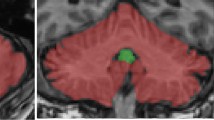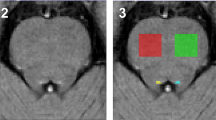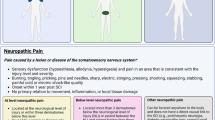Abstract
Upper cervical cord area (UCCA) atrophy is a prognostic marker for clinical progression in longstanding multiple sclerosis (MS). The objectives of the study were to quantify UCCA atrophy and evaluate its impact in clinically isolated syndrome (CIS) and relapsing–remitting MS (RRMS); to compare converting CIS patients with stable CIS, and to study changes of UCCA and brain white matter (WM) and grey matter (GM) at 2-year follow-up. 110 therapy-naive patients including 53 CIS [6 ± 6 months after symptom onset (SO)] and 57 early RRMS (SO: 12 ± 9 months) underwent sagittal 3D-T1w brain MR (3T). Mean UCCA (C1–C3 level), WM and GM, disability status (EDSS), pyramidal and sensory functional scores, motoric fatigue were assessed at baseline (BL), 12 and 24 months. Volumes were compared with 34 age- and gender-matched healthy controls to assess atrophy. RRMS (78.1 ± 8.7 mm2, p = 0.011) and converting CIS (77.3 ± 8.0 mm2, p = 0.046) presented with baseline UCCA atrophy, when compared with controls (82.7 ± 5.2 mm2), but not stable CIS (82.6 ± 7.4 mm2, p = 0.998). Baseline WM was reduced in RRMS (509.3 ± 25.7 ml vs. controls: 528.4 ± 24.1 ml, p = 0.032). Baseline UCCA correlated negative with muscular weakness and fatigability in all patients and RRMS. EDSS exceeding 3 was associated with lower baseline UCCA. Longitudinal atrophy rates were higher in UCCA than in brain volumes. Early cervical cord atrophy in CIS and RRMS was confirmed and may represent a potential new risk marker for conversion from CIS to MS. Baseline atrophy and atrophy change rates were higher in UCCA compared to WM and GM, suggesting that cervical cord volumetry might become an additional MRI marker relevant in future clinical studies in CIS and early MS.


Similar content being viewed by others
References
Gass A, Rocca MA, Agosta F, Ciccarelli O, Chard D, Valsasina P, Brooks JC, Bischof A, Eisele P, Kappos L, Barkhof F, Filippi M, Group MS (2015) MRI monitoring of pathological changes in the spinal cord in patients with multiple sclerosis. Lancet Neurol 14(4):443–454. doi:10.1016/S1474-4422(14)70294-7
Polman CH, Reingold SC, Banwell B, Clanet M, Cohen JA, Filippi M, Fujihara K, Havrdova E, Hutchinson M, Kappos L, Lublin FD, Montalban X, O’Connor P, Sandberg-Wollheim M, Thompson AJ, Waubant E, Weinshenker B, Wolinsky JS (2011) Diagnostic criteria for multiple sclerosis: 2010 revisions to the McDonald criteria. Ann Neurol 69(2):292–302. doi:10.1002/ana.22366
Polman CH, Reingold SC, Edan G, Filippi M, Hartung HP, Kappos L, Lublin FD, Metz LM, McFarland HF, O’Connor PW, Sandberg-Wollheim M, Thompson AJ, Weinshenker BG, Wolinsky JS (2005) Diagnostic criteria for multiple sclerosis: 2005 revisions to the “McDonald Criteria”. Ann Neurol 58(6):840–846. doi:10.1002/ana.20703
Bonati U, Fisniku LK, Altmann DR, Yiannakas MC, Furby J, Thompson AJ, Miller DH, Chard DT (2011) Cervical cord and brain grey matter atrophy independently associate with long-term MS disability. J Neurol Neurosurg Psychiatry 82(4):471–472. doi:10.1136/jnnp.2010.205021
Daams M, Weiler F, Steenwijk MD, Hahn HK, Geurts JJ, Vrenken H, van Schijndel RA, Balk LJ, Tewarie PK, Tillema JM, Killestein J, Uitdehaag BM, Barkhof F (2014) Mean upper cervical cord area (MUCCA) measurement in long-standing multiple sclerosis: relation to brain findings and clinical disability. Mult Scler 20(14):1860–1865. doi:10.1177/1352458514533399
Losseff NA, Webb SL, O’Riordan JI, Page R, Wang L, Barker GJ, Tofts PS, McDonald WI, Miller DH, Thompson AJ (1996) Spinal cord atrophy and disability in multiple sclerosis. A new reproducible and sensitive MRI method with potential to monitor disease progression. Brain 119(Pt 3):701–708
Lukas C, Sombekke MH, Bellenberg B, Hahn HK, Popescu V, Bendfeldt K, Radue EW, Gass A, Borgwardt SJ, Kappos L, Naegelin Y, Knol DL, Polman CH, Geurts JJ, Barkhof F, Vrenken H (2013) Relevance of spinal cord abnormalities to clinical disability in multiple sclerosis: MR imaging findings in a large cohort of patients. Radiology 269(2):542–552. doi:10.1148/radiol.13122566
Rocca MA, Horsfield MA, Sala S, Copetti M, Valsasina P, Mesaros S, Martinelli V, Caputo D, Stosic-Opincal T, Drulovic J, Comi G, Filippi M (2011) A multicenter assessment of cervical cord atrophy among MS clinical phenotypes. Neurology 76(24):2096–2102. doi:10.1212/WNL.0b013e31821f46b8
Biberacher V, Boucard CC, Schmidt P, Engl C, Buck D, Berthele A, Hoshi MM, Zimmer C, Hemmer B, Muhlau M (2015) Atrophy and structural variability of the upper cervical cord in early multiple sclerosis. Mult Scler 21(7):875–884. doi:10.1177/1352458514546514
Furby J, Hayton T, Anderson V, Altmann D, Brenner R, Chataway J, Hughes R, Smith K, Miller D, Kapoor R (2008) Magnetic resonance imaging measures of brain and spinal cord atrophy correlate with clinical impairment in secondary progressive multiple sclerosis. Mult Scler 14(8):1068–1075. doi:10.1177/1352458508093617
Kearney H, Yiannakas MC, Abdel-Aziz K, Wheeler-Kingshott CA, Altmann DR, Ciccarelli O, Miller DH (2014) Improved MRI quantification of spinal cord atrophy in multiple sclerosis. J Magn Reson Imaging 39(3):617–623. doi:10.1002/jmri.24194
Lin X, Tench CR, Turner B, Blumhardt LD, Constantinescu CS (2003) Spinal cord atrophy and disability in multiple sclerosis over four years: application of a reproducible automated technique in monitoring disease progression in a cohort of the interferon beta-1a (Rebif) treatment trial. J Neurol Neurosurg Psychiatry 74(8):1090–1094
Rocca MA, Preziosa P, Mesaros S, Pagani E, Dackovic J, Stosic-Opincal T, Drulovic J, Filippi M (2016) Clinically isolated syndrome suggestive of multiple sclerosis: dynamic patterns of gray and white matter changes—a 2-year MR imaging study. Radiology 278(3):841–853. doi:10.1148/radiol.2015150532
Stevenson VL, Leary SM, Losseff NA, Parker GJ, Barker GJ, Husmani Y, Miller DH, Thompson AJ (1998) Spinal cord atrophy and disability in MS: a longitudinal study. Neurology 51(1):234–238
Brex PA, Leary SM, O’Riordan JI, Miszkiel KA, Plant GT, Thompson AJ, Miller DH (2001) Measurement of spinal cord area in clinically isolated syndromes suggestive of multiple sclerosis. J Neurol Neurosurg Psychiatry 70(4):544–547
Losseff NA, Wang L, Lai HM, Yoo DS, Gawne-Cain ML, McDonald WI, Miller DH, Thompson AJ (1996) Progressive cerebral atrophy in multiple sclerosis. A serial MRI study. Brain 119(Pt 6):2009–2019
Stevenson VL, Miller DH, Leary SM, Rovaris M, Barkhof F, Brochet B, Dousset V, Filippi M, Hintzen R, Montalban X, Polman CH, Rovira A, de Sa J, Thompson AJ (2000) One year follow up study of primary and transitional progressive multiple sclerosis. J Neurol Neurosurg Psychiatry 68(6):713–718
Brownlee WJ, Altmann DR, Alves Da Mota P, Swanton JK, Miszkiel KA, Wheeler-Kingshott CG, Ciccarelli O, Miller DH (2016) Association of asymptomatic spinal cord lesions and atrophy with disability 5 years after a clinically isolated syndrome. Mult Scler. doi:10.1177/1352458516663034
Calabrese M, Rinaldi F, Mattisi I, Bernardi V, Favaretto A, Perini P, Gallo P (2011) The predictive value of gray matter atrophy in clinically isolated syndromes. Neurology 77(3):257–263. doi:10.1212/WNL.0b013e318220abd4
Filippi M, Rocca MA, Calabrese M, Sormani MP, Rinaldi F, Perini P, Comi G, Gallo P (2010) Intracortical lesions: relevance for new MRI diagnostic criteria for multiple sclerosis. Neurology 75(22):1988–1994. doi:10.1212/WNL.0b013e3181ff96f6
Kurtzke JF (1983) Rating neurologic impairment in multiple sclerosis: an expanded disability status scale (EDSS). Neurology 33(11):1444–1452
Penner IK, Raselli C, Stocklin M, Opwis K, Kappos L, Calabrese P (2009) The fatigue scale for motor and cognitive functions (FSMC): validation of a new instrument to assess multiple sclerosis-related fatigue. Mult Scler 15(12):1509–1517. doi:10.1177/1352458509348519
Schmidt P, Gaser C, Arsic M, Buck D, Forschler A, Berthele A, Hoshi M, Ilg R, Schmid VJ, Zimmer C, Hemmer B, Muhlau M (2012) An automated tool for detection of FLAIR-hyperintense white-matter lesions in multiple sclerosis. Neuroimage 59(4):3774–3783. doi:10.1016/j.neuroimage.2011.11.032
Whitwell JL, Crum WR, Watt HC, Fox NC (2001) Normalization of cerebral volumes by use of intracranial volume: implications for longitudinal quantitative MR imaging. AJNR 22(8):1483–1489
Faul F, Erdfelder E, Lang AG, Buchner A (2007) G*Power 3: a flexible statistical power analysis program for the social, behavioral, and biomedical sciences. Behav Res Methods 39(2):175–191
Furby J, Hayton T, Altmann D, Brenner R, Chataway J, Smith KJ, Miller DH, Kapoor R (2010) A longitudinal study of MRI-detected atrophy in secondary progressive multiple sclerosis. J Neurol 257(9):1508–1516. doi:10.1007/s00415-010-5563-y
Lukas C, Knol DL, Sombekke MH, Bellenberg B, Hahn HK, Popescu V, Weier K, Radue EW, Gass A, Kappos L, Naegelin Y, Uitdehaag BM, Geurts JJ, Barkhof F, Vrenken H (2015) Cervical spinal cord volume loss is related to clinical disability progression in multiple sclerosis. J Neurol Neurosurg Psychiatry 86(4):410–418. doi:10.1136/jnnp-2014-308021
Valsasina P, Rocca MA, Horsfield MA, Copetti M, Filippi M (2015) A longitudinal MRI study of cervical cord atrophy in multiple sclerosis. J Neurol 262(7):1622–1628. doi:10.1007/s00415-015-7754-z
Lukas C, Minneboo A, de Groot V, Moraal B, Knol DL, Polman CH, Barkhof F, Vrenken H (2010) Early central atrophy rate predicts 5 year clinical outcome in multiple sclerosis. J Neurol Neurosurg Psychiatry 81(12):1351–1356. doi:10.1136/jnnp.2009.199968
Kearney H, Schneider T, Yiannakas MC, Altmann DR, Wheeler-Kingshott CA, Ciccarelli O, Miller DH (2015) Spinal cord grey matter abnormalities are associated with secondary progression and physical disability in multiple sclerosis. J Neurol Neurosurg Psychiatry 86(6):608–614. doi:10.1136/jnnp-2014-308241
Valsasina P, Rocca MA, Horsfield MA, Absinta M, Messina R, Caputo D, Comi G, Filippi M (2013) Regional cervical cord atrophy and disability in multiple sclerosis: a voxel-based analysis. Radiology 266(3):853–861. doi:10.1148/radiol.12120813
Rocca MA, Absinta M, Valsasina P, Copetti M, Caputo D, Comi G, Filippi M (2012) Abnormal cervical cord function contributes to fatigue in multiple sclerosis. Mult Scler 18(11):1552–1559. doi:10.1177/1352458512440516
Dalton CM, Chard DT, Davies GR, Miszkiel KA, Altmann DR, Fernando K, Plant GT, Thompson AJ, Miller DH (2004) Early development of multiple sclerosis is associated with progressive grey matter atrophy in patients presenting with clinically isolated syndromes. Brain 127(Pt 5):1101–1107. doi:10.1093/brain/awh126
Tiberio M, Chard DT, Altmann DR, Davies G, Griffin CM, Rashid W, Sastre-Garriga J, Thompson AJ, Miller DH (2005) Gray and white matter volume changes in early RRMS: a 2-year longitudinal study. Neurology 64(6):1001–1007. doi:10.1212/01.WNL.0000154526.22878.30
Fisher E, Lee JC, Nakamura K, Rudick RA (2008) Gray matter atrophy in multiple sclerosis: a longitudinal study. Ann Neurol 64(3):255–265. doi:10.1002/ana.21436
Fisher E, Rudick RA, Simon JH, Cutter G, Baier M, Lee JC, Miller D, Weinstock-Guttman B, Mass MK, Dougherty DS, Simonian NA (2002) Eight-year follow-up study of brain atrophy in patients with MS. Neurology 59(9):1412–1420
Paolillo A, Pozzilli C, Giugni E, Tomassini V, Gasperini C, Fiorelli M, Mainero C, Horsfield M, Galgani S, Bastianello S, Buttinelli C (2002) A 6-year clinical and MRI follow-up study of patients with relapsing-remitting multiple sclerosis treated with Interferon-beta. Eur J Neurol 9(6):645–655
Bellenberg B, Schneider R, Weiler F, Suchan B, Haghikia A, Hoffjan S, Gold R, Koster O, Lukas C (2015) Cervical cord area is associated with infratentorial grey and white matter volume predominantly in relapsing-remitting multiple sclerosis: a study using semi-automated cord volumetry and voxel-based morphometry. Mult Scler Relat Disord 4(3):264–272. doi:10.1016/j.msard.2015.04.003
Acknowledgements
This work was supported by the German Federal Ministry for Education and Research, BMBF, German Competence Network Multiple Sclerosis (KKNMS), Grant No. 01GI1307A and Grant No. 01GI0914.
Author information
Authors and Affiliations
Corresponding author
Ethics declarations
Ethical standards
The study was approved by the local ethics committee (Approval No. 3714-10) and was performed in accordance with the ethical standards laid down in the 1964 Declaration of Helsinki. Written informed consent was obtained from all participants prior to inclusion in the study.
Conflicts of interest
BB and AS received funding by the German Federal Ministry for Education and Research, BMBF, German Competence Network Multiple Sclerosis (KKNMS), Grant No. 01GI1601I and Grant No. 01GI0914. CL received a research grant by the German Federal Ministry for Education and Research, BMBF, German Competence Network Multiple Sclerosis (KKNMS), Grant No. 01GI1601I, has received consulting and speaker’s honoraria from BiogenIdec, Bayer Schering, Novartis, Sanofi, Genzyme and TEVA, and has received research scientific grant support from Bayer Schering, TEVA and MerckSerono. He holds an endowed professorship supported by the Novartis Foundation. RG received a research grant by the German Federal Ministry for Education and Research, BMBF, German Competence Network Multiple Sclerosis (KKNMS), Grant No. 01GI0914, has received honoraria, consultant fees or other support from Baxter, Bayer Schering, Biogen Idec, CLB, Behring, Genzyme, Merck Serono, Novartis, Talecris, Teva and Wyeth. All other authors declare that they have no conflict of interest in relation to the material presented in this manuscript.
Electronic supplementary material
Below is the link to the electronic supplementary material.
Rights and permissions
About this article
Cite this article
Hagström, I.T., Schneider, R., Bellenberg, B. et al. Relevance of early cervical cord volume loss in the disease evolution of clinically isolated syndrome and early multiple sclerosis: a 2-year follow-up study. J Neurol 264, 1402–1412 (2017). https://doi.org/10.1007/s00415-017-8537-5
Received:
Revised:
Accepted:
Published:
Issue Date:
DOI: https://doi.org/10.1007/s00415-017-8537-5




